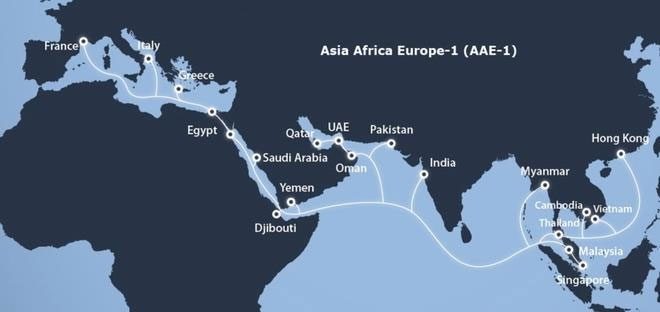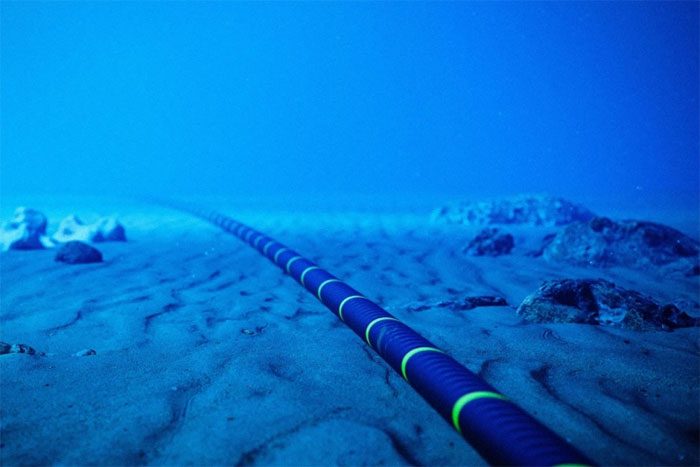Responsible for the majority of global Internet traffic, undersea cables are surprisingly “fragile,” especially the cable that runs through the Red Sea, connecting Vietnam to the world.
The Asia Africa Europe 1 (AAE-1) submarine cable is one of the key cables in the global Internet network. Stretching over 25,000 km, AAE-1 connects the South China Sea to Europe, delivering Internet access to more than 10 countries, including Vietnam.
Consequently, a significant cable break on June 7 in the Red Sea, near Egypt, caused millions to experience unstable Internet connections and complete outages.
The Backbone of the Global Internet
At that time, experts could not identify the cause, but the incident with the AAE-1 cable “affected 7 countries and numerous critical services,” said Rosalind Thomas, Director of SAEx International Management.

AAE-1 is one of the important submarine cables connecting Asia, Africa, and Europe. (Photo: AAEone)
Among the affected, Ethiopia suffered the most severe consequences, losing 90% of its Internet connectivity. Cloud services from Google, Microsoft, and Amazon also went offline.
This incident highlights the fact that undersea cables are indeed very “fragile” yet play a crucial role in the Internet’s infrastructure. They are a vital part of the Internet backbone, responsible for transmitting the majority of data globally, while also connecting various networks such as mobile towers and Wi-Fi connections.
Notably, the Red Sea, located in the Middle East between Egypt and Saudi Arabia, is considered one of the largest Internet connection points in the world, but it is also the most vulnerable part of this system. Sixteen submarine cables traverse this area and can easily be damaged by ship anchors or earthquakes.

International submarine cable incidents frequently occur, especially in the Asian region. (Photo: Getty Images)
“Wherever the most traffic flows, there will be vulnerabilities. Because it is a hub for many global cables, the Red Sea has become the weakest link in the world’s Internet“, noted Nicole Starosielski, a professor at New York University.
Egypt as the “Bottleneck”
In fact, about 17% of global Internet traffic must pass through the Red Sea cable at a speed of 178 million MB/s.
According to Doug Madory, Director of Internet Analysis at Kentik, the geographical characteristics are the primary reason why the waters near Egypt have become the “bottleneck” of the global Internet. To minimize the cable length, it must pass through this country.
Conversely, if the cable were to go through other regions, it would have to traverse Syria, Iraq, Iran, or Afghanistan, areas often affected by conflict. Handling such a massive volume of data, this area frequently experiences outages. “The Red Sea in Egypt has shallow waters, making it very susceptible to cable breaks”, Madory stated.
To mitigate the worst-case scenarios, technology companies utilize multiple cable routes for data transmission. If one cable is damaged, traffic can be rerouted to other cables. This is also why giants like Google, Facebook, and Microsoft have invested hundreds of millions of USD to build their own undersea Internet cables in recent years.
However, these solutions cannot yet replace traditional submarine cables. For example, Elon Musk’s Starlink satellite Internet service can only be used in remote areas or as a backup option.
“They cannot handle hundreds of terabits of data flowing across continents. Only undersea cables can do that”, said Alan Mauldin, Research Director at TeleGeography.
Therefore, organizations need to implement measures to protect the cables running through Egypt. “This cable route is crucial for national security and the economy as it plays an important role in keeping everything operational”, Mauldin noted.
Experts indicate that many “stations” on land allowing fiber optic cables to pass through have been built near the Egyptian coastline. The telecommunications companies in this country have also begun establishing terrestrial cable routes along the Suez Canal, using concrete conduits to protect the Internet cables.
In July 2021, Google also launched the Blue-Raman submarine cable, connecting India to France via the Red Sea, without passing through Egypt.

















































